How to build human connections in an async workplace
By Chase Warrington
This week we're tackling one of the biggest challenges of remote — and particularly async-first — work: a lack of human connection.
Doist is about as async-first as it gets, and I have literally cried when coworkers have decided to leave. It is 100% possible to build a strong team culture that respects people's time and attention and fosters deep personal connections.
In today's newsletter, our Head of Remote, Chase Warrington, explains why leaders often focus on the wrong things when it comes to team culture, and lays out Doist's approach to creating human connection as an async-first team.
In 2023, the question isn't can companies build a strong team culture remotely, but whether or not they'll put in the time and intention to do it well.
Until next time,
Becky and the Twist team

The inspiration for this post came from a recent Running Remote event — the world’s largest virtual conference for advancing the “future of work” — where I participated in an "Ask Me Anything" session centered around async communication.
I expected a handful of people to attend and questions related to which tools to use to facilitate remote work, or the best practices we implement at Doist to keep 100 people across all time zones rowing in the same direction.
I was wrong.
It turned out to be the highest-attended event at the conference, and I was peppered with questions that centered on one theme: maintaining the “human element” in a remote, async environment.
The conversation around remote work is quickly shifting from “how do we make this work right now” to “how do we optimize remote work for the long term.” Team leaders are no longer satisfied with the immediate productivity benefits of remote work. They’re now shifting the focus to building relationships with colleagues at a distance, promoting team camaraderie, and cultivating organizational culture — those vital elements of any team that exist outside the confines of KPIs and OKRs.
It’s a refreshing change.
Humans are social beings by nature, and we crave interaction with our peers. Many will say this is the trade off you inevitably have to make when you transition to remote work, but my experience tells me that just isn’t true. In this article, I’ll outline how we think about culture and camaraderie as a remote, async-first team and then delve into exactly how we foster human connection within a distributed “workplace.”
Focus on these things first
When people ask about building a cohesive team culture, creating camaraderie, and fostering human connections remotely, what they usually mean is “how do you recreate the social interactions you get in an office?”
We tend to equate a strong team culture with a team that builds personal bonds outside of their work. Don’t get me wrong: connecting with teammates on a personal level can be an important component of culture. But over my years at Doist, I’ve come to realize that team culture and human connection is primarily built by how you work together — not how you socialize together.
(That’s true for co-located teams too, but it becomes even more apparent when companies can no longer use a pool table and a well-stocked fridge as a stand-in for team culture.)
Doist had a strong company culture long before we started doing virtual “casual hangouts” or even in-person retreats (more on those later). Here are just a few of the ways we build team culture that are far more important than how we socialize together:
- Deciding who to hire and who to promote (and, when necessary, who to fire)
- Praising each other’s work publicly
- Normalizing disagreeing with each other publicly and respectfully
- Building products that align with our values
- Choosing which projects to prioritize and which to say no to
- Giving team members autonomy over their work
- Trusting team members to set their own schedules
- Respecting people’s off-hours including totally disconnected vacations
- Deciding which benefits to offer and how to fairly calculate salaries
Moreover, when your team’s culture relies heavily on face time and social interactions, it can easily create an environment that favors those who are able and want to attend team-building activities at the expense of those who prefer to stay heads down in their work. There’s nothing worse than an “optional” happy hour with professional repercussions if you don’t attend, whether those repercussions are intentional or not.
Fostering greater social connections won’t create a stronger team culture unless you’re first operating on clear and consistent values in your work. Start there first. Don’t let a focus on creating social connections distract you from all of the other things that create a strong cultural foundation.
Three principles for fostering the social side of team culture
Before diving into how we create space for personal connections at Doist, it’s worth mentioning three guidelines we keep in mind to make sure that social activities are helpful and not just getting in the way:
- Make attendance truly optional. Some people want more socializing, some don’t. We don’t pressure Doisters to participate in a work meeting if it’s not convenient for them, so we certainly won’t force them to join a game or even a company retreat. By making it completely optional to participate with no guilt strings or professional repercussions attached if you opt out, you’ll serve those that truly crave this interaction and create a better outcome for all involved.
- Treat social activities as part of the workday, not an extracurricular. We’re all ambitious with plenty of work to do. If forced to choose between your core work or a social activity, it’s likely many of us will choose to focus on our obligations. Or worse, we’ll feel obligated to extend our workdays to do both. Fostering human connections should be seen as vital to the long-term success of the company. Leadership should encourage direct reports to work these activities into their schedules, not add them on top of an already full workload.
- Remember what truly unites us: our work. The work we do is what actually brings us together. That’s ok (and frankly healthy) to admit. One of the biggest benefits of remote work is that it provides you the opportunity to spend more on the people and things you care about outside of work. Let’s not sabotage that with a bunch of forced and awkward social events for teammates to attend on top of their work duties. Quantity of activities is not the objective here. We’re aiming for a handful of quality options to help foster a healthy balance of focusing on meaningful work and building connections with teammates across the globe.
Guided by those three principles, we have three buckets of social team-building activities at Doist:
- In-person meetups
- Real-time, virtual activities
- Async, virtual socializing
In-person meetups
Though we’re a remote-first company, we make an effort to meet up regularly in real life (IRL). Our first annual company-wide retreat took place in Menorca seven years ago, and our team meetups have expanded in scope over time. They’re well worth the money spent.
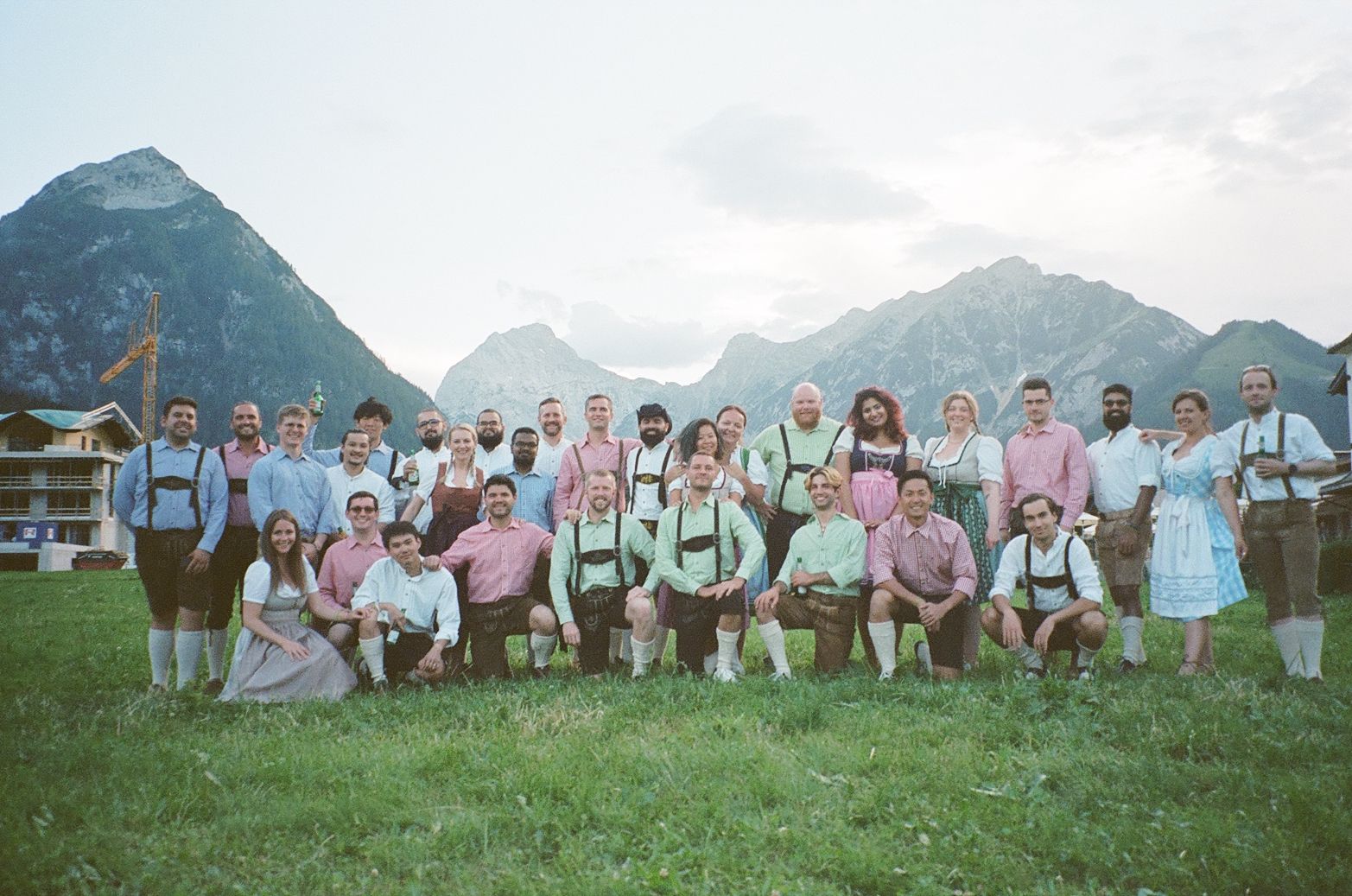
At Doist, we have four ways we encourage IRL meetups:
- Company-wide retreats. Once per year (pre-covid) we bring the whole company together in one location for a week. Most recently we were in Pertisau, Austria (aka Doistberg), and we’re scheduled to meet again in Italy in 2023.
- Team “mini” retreats. Three years ago we started incorporating what we call “mini-retreats” into the calendar. Each team has the budget to get together in person once each year. Usually we hold these about six months after the company-wide retreat, so people can look forward to seeing other Doisters every six months.
- Mentorship trips. Joining a remote company can be intimidating, and the prospect of not actually meeting any of your teammates for several months can be a bit depressing (ask anyone who joined Doist at the start of 2020). We recognized that one of the keys to employee retention was helping new hires establish relationships early on in their careers with Doist, so we incorporated mentorship trips into the onboarding process. Each new hire is assigned a peer mentor on their team. During the first month at Doist, they spend a week working (and hanging out) together in one of their hometowns.
- (new) Meetup stipends. We’re constantly evolving how we encourage connections between Doisters. Most recently, we introduced a meetup stipend. We will reimburse up to $200 per year for travel and entertainment expenses when Doisters choose to meet up somewhere in the world. Whether it’s a flight, a dinner, a couple coffees, or a concert ticket — if you want to meetup to hang out with your teammates, we support that! Doisters often incorporate seeing coworkers into their travel plans.
With all IRL meetups, remember that this time should primarily be used for the aspects of teamwork that are not as easy to accomplish in a distributed environment: the human element. It can be tempting to schedule a lot of meetings and brainstorming sessions, but the truth is, these are usually more productive (not to mention inclusive) when done virtually. Leave the work for the other 50 weeks in the year.
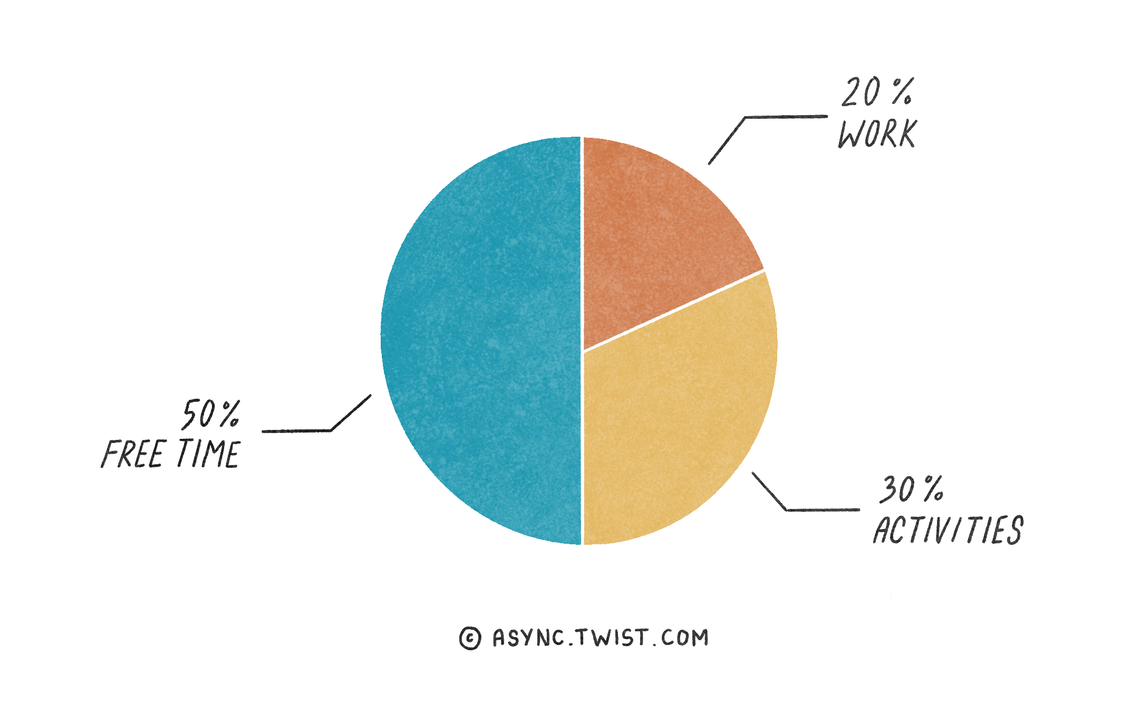
Don’t over-schedule the agenda with activities — leave plenty of time for organic conversation to take place. And remember to build in time for recharging the batteries. When you’ve become accustomed to working from home in solitude, suddenly being thrust into ten hours of socializing per day for several days in a row is exhausting. Especially for introverts. Reserve time for people to be alone and recharge as they need to, so they’ll be able to show up for planned activities in a much deeper way.
Virtual, real-time activities
While in-person meetups are great, we can’t afford to do these very often. We’re an async-first company, but that doesn’t mean we’re async-only. Here are a few fun ways we’ve started to connect virtually, in real-time as a team:
- Doist Talks. A series created by my colleague on the back-end team, Modasser, Doist Talks are monthly gatherings held over Zoom where a teammate showcases a skill, process, or tool that they’re passionate about. Doisters have presented on a wide range of topics, from how to get more out of tools like Figma to the history of parts of our back-end code. The meeting lasts for an hour, with a presentation by the volunteer for the month and time for Q&A. We also record these sessions to be viewed later by anyone that wasn’t able to attend, and we try to stagger the times so people around the world have an opportunity to join live. These talks give us a chance to bond over our work outside of our day-to-day jobs.
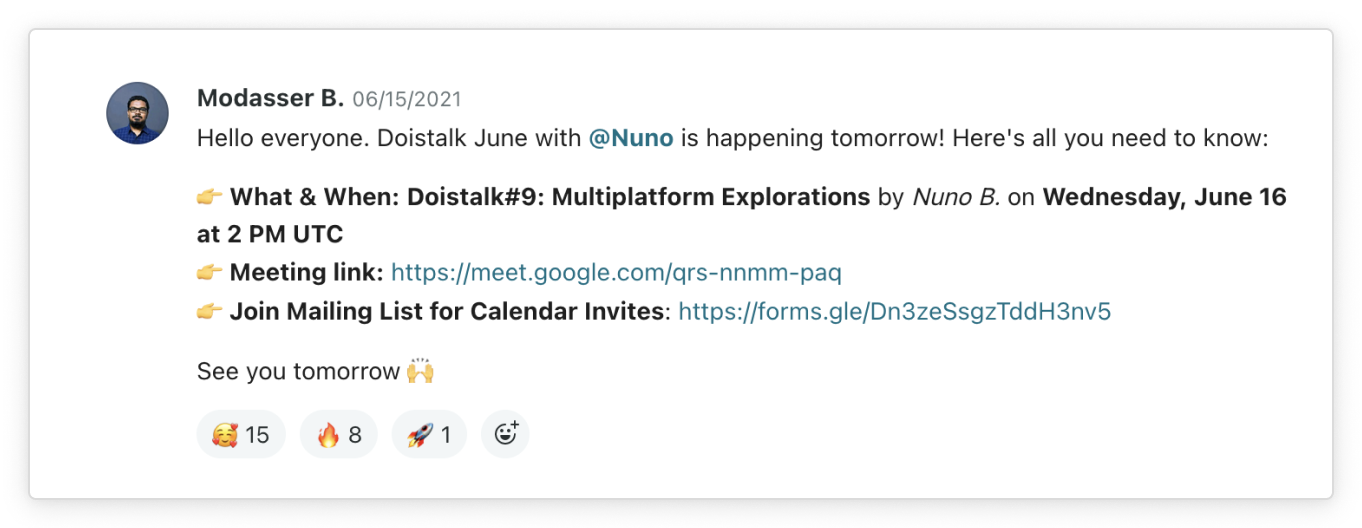
- Doist Presents. Similar to Doist Talks but with a more “outside of work” spin — the Instagram to the Doist Talks LinkedIn, if you will. Each month a teammate volunteers to host a Zoom/Meet call, and lead a group in an activity. We’ve had yoga and fitness sessions, cooked meals together, and have plans for drawing classes, jam sessions, and more.
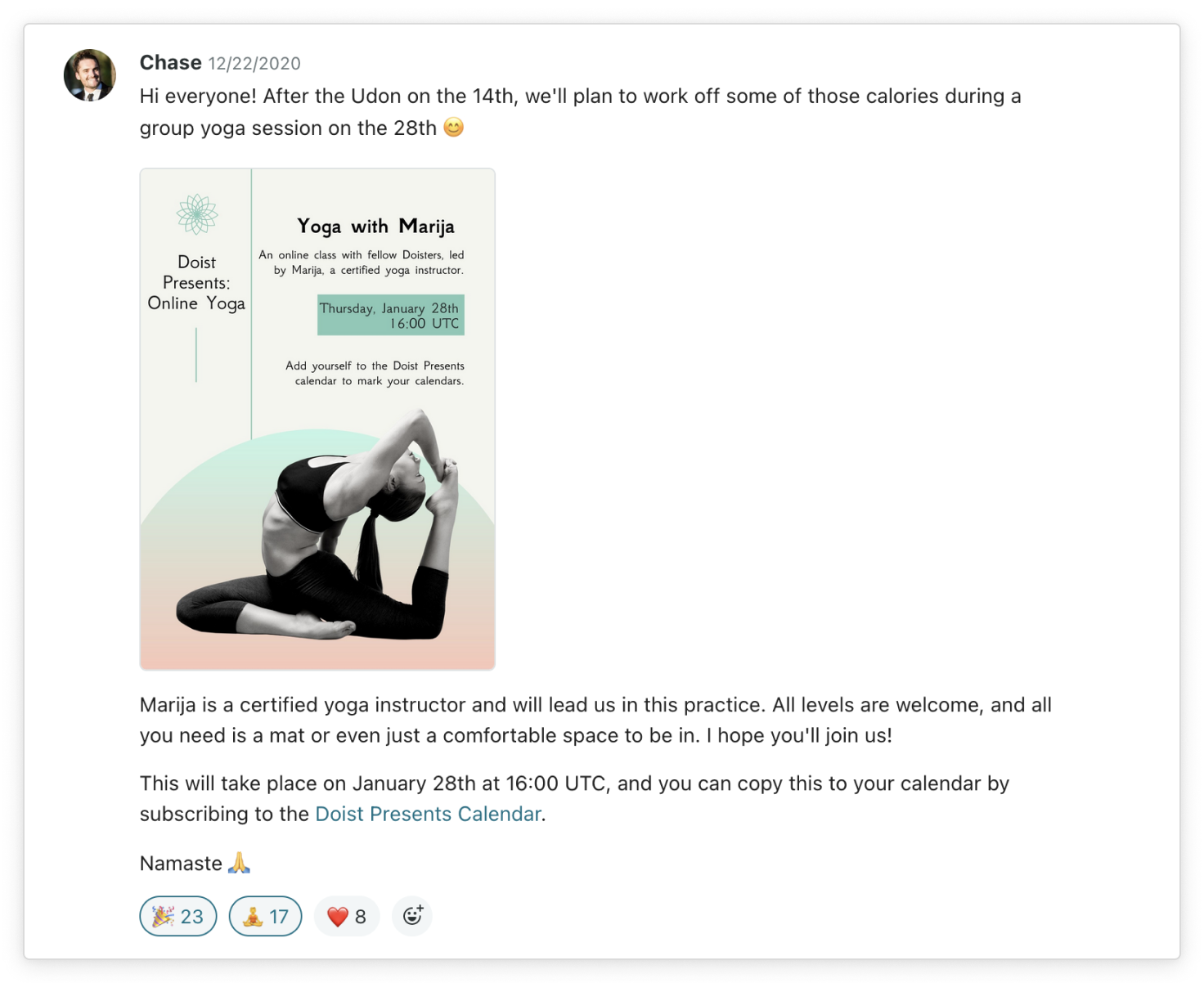
- Casual hangouts. Each month Doisters can opt into a one-hour casual chat on their meeting platform of choice with 2-3 other teammates, selected at random. Our People Ops team sends out a form asking if you’d like to participate. If you respond yes, you’re paired with a couple of teammates and assigned a leader within the group to find the best time for everyone during the month. Groups often take a screenshot and share with the team afterward.

- Team syncs. We don’t have company-wide all-hands meetings. Coordinating 100 people across all time zones to sit on a Zoom call at odd hours of someone’s night isn’t worth it. But most teams at Doist have occasional team-wide call between weekly and monthly. These meetings serve more as an excuse to get together than for getting things done. We use this meeting time to connect on a human level, share some laughs, and brainstorm ideas a bit in real-time. At our monthly marketing meeting, we start each session with a lighthearted question, like, “what superpower do you wish you had?” or accompany our discussion with a Figma/Miro board to jot down ideas discussed during the session. Afterwards, we usually continue the discussion asynchronously in a dedicated Twist thread.
- Hello Doist. A quarterly series where we bring in 3rd-party experts to lead us in virtual activities that help us work together and connect on a deeper level. From breathwork to brainstorming, we want to give Doisters access to the best leaders in their respective fields, and help our teammates connect and thrive in new ways.
Async socializing
We communicate asynchronously 80% of the time for work, so it feels natural for us to socialize asynchronously too. Some people assume async communication is impersonal, but as is the case with distributed work in general, it just takes a bit of creativity and intention. Here are a handful of ways we bring connect on a personal level asynchronously:
- Social channels and threads. We have nearly twenty Twist channels dedicated to non-work interests. These topics range from #Gaming and #Gardening to #Crypto and #Cooking. Providing these spaces for human interaction inside our primary work communication tool makes it easy for Doisters to connect on a daily basis asynchronously. Participation is optional, and since Twist is designed to reduce noise and notifications, only those that are truly interested are “distracted” by these discussions. Additional channels include #Mindfulness, #Parenting, #Health/Fitness, #Coffee, and #BookClub, among others.
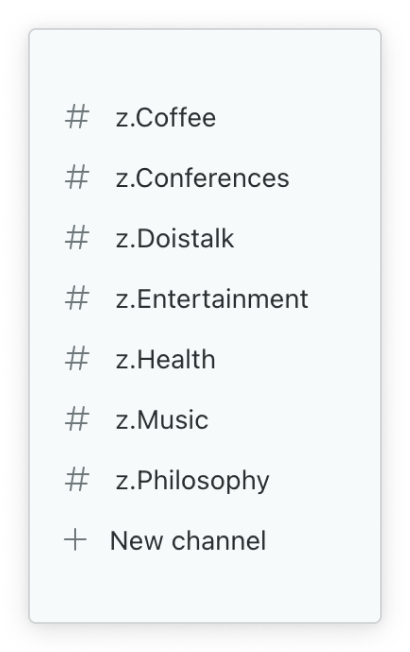
Automated check-ins. We built a series of fun automated check-ins in Twist to prompt interesting non-work discussions and to share more about our personal lives, hometowns, and home countries. Here are some examples of these automated threads:
- What did you do this weekend?
- Happy Birthday wishes on a teammate's birthday
- Work anniversary celebrations

- Ask Doist threads. If bots aren’t your thing, one of our teammates has taken it upon himself to create “Ask Doist” threads, where he occasionally asks everyone in the company a random, often humorous, and always interesting question. Past threads have ranged from What do you put on your toast? to Do you have a word or phrase to avoid campfire smoke? to Tell us about a person known for their good actions in your country that we should know about.
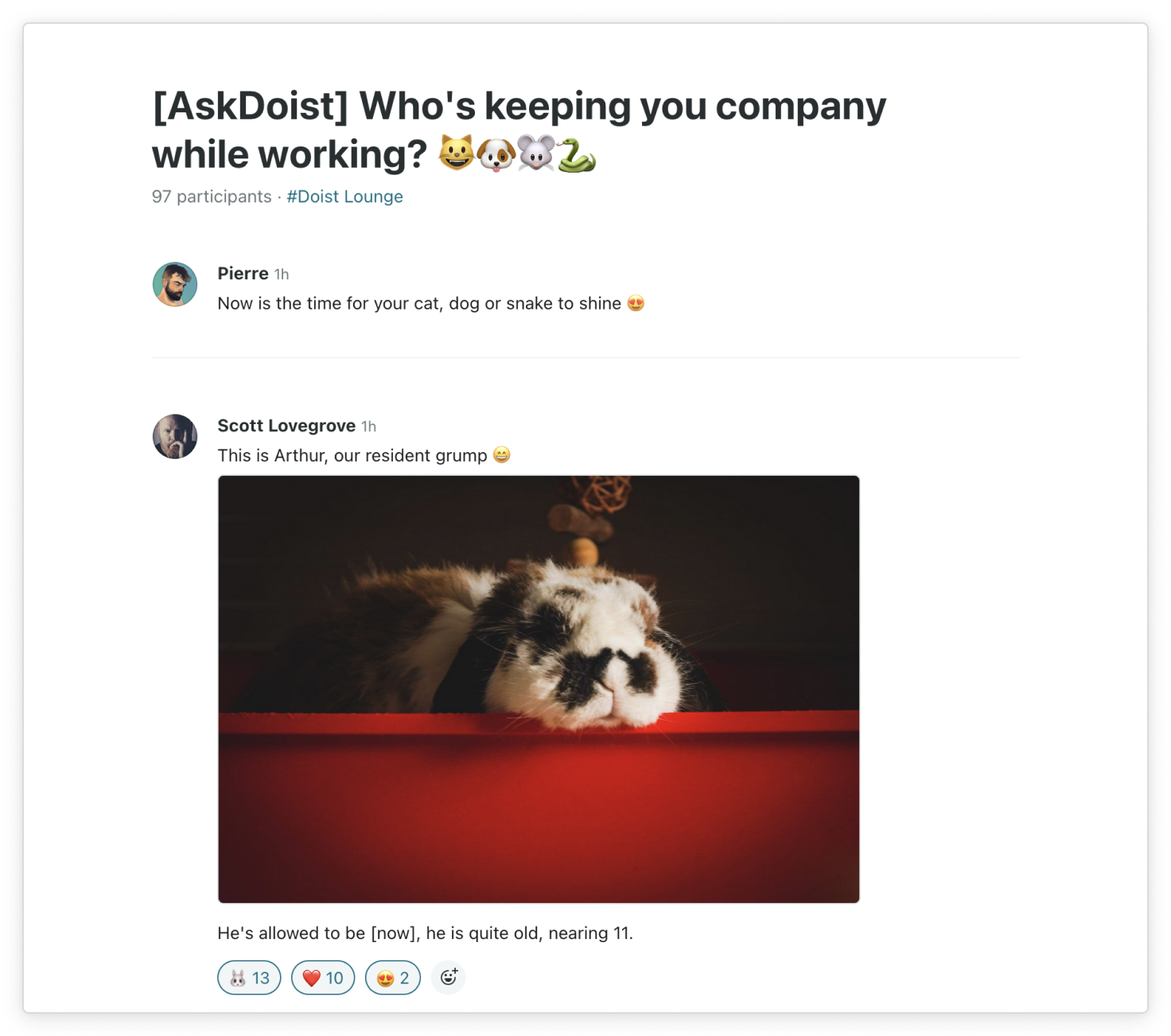
- 10 interesting facts threads. One of the first tasks assigned to a new hire is to share 10 interesting facts about themselves with the whole company. This small change to our onboarding process has paid huge dividends. As opposed to sharing their LinkedIn profile or quickly introducing themselves in a real-time meeting, we want to get to know our new teammate on a more personal level. New Doisters are encouraged to take their time on this, and dive deep on any side projects, interests, or beliefs. It’s incredible to see how quickly bonds over mutual interests are formed over such discussions.
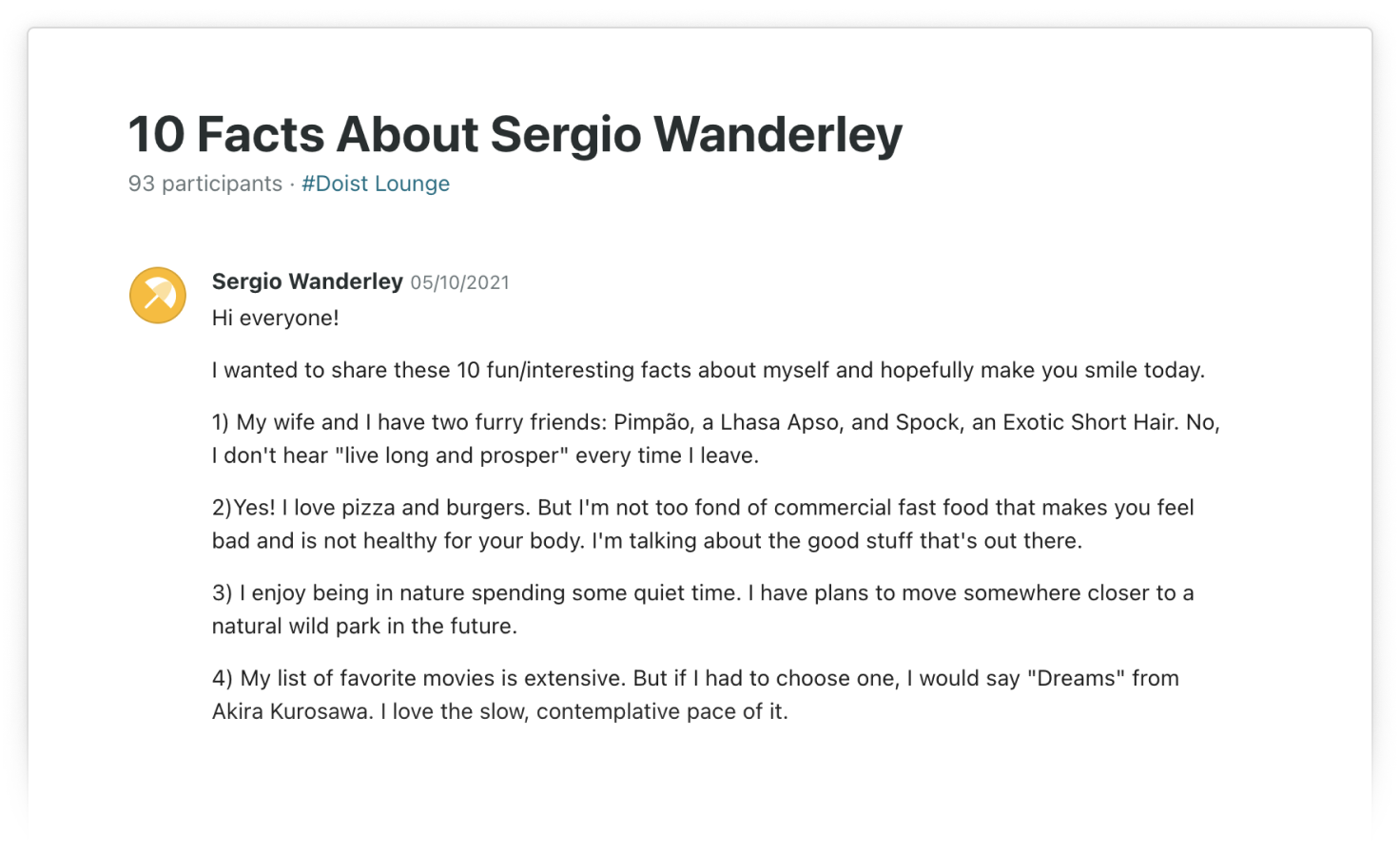
- Async games. You’re never too old for some game time, right? We recently started playing a few async games like Two Truths and a Lie in a dedicated Twist thread with votes via reaction and even async Telephone via Todoist tasks and voice comments with the winning team announced in some creative ways.
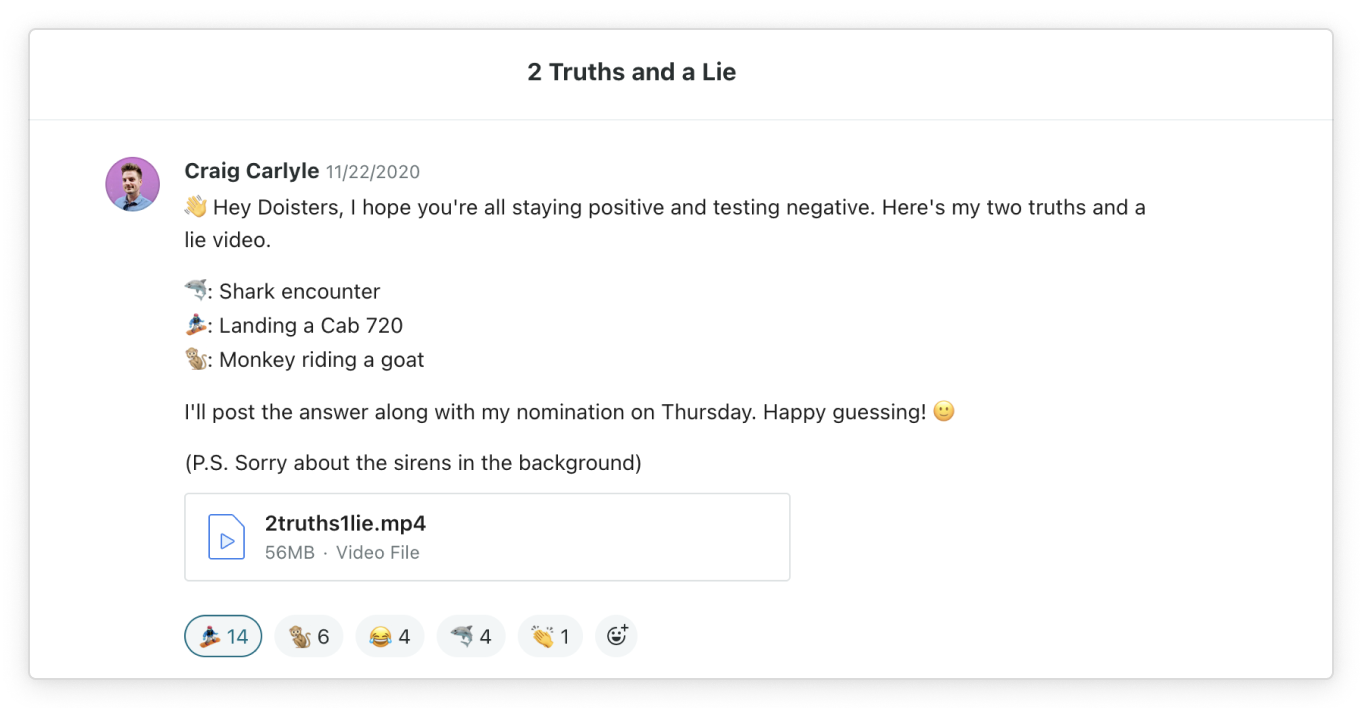
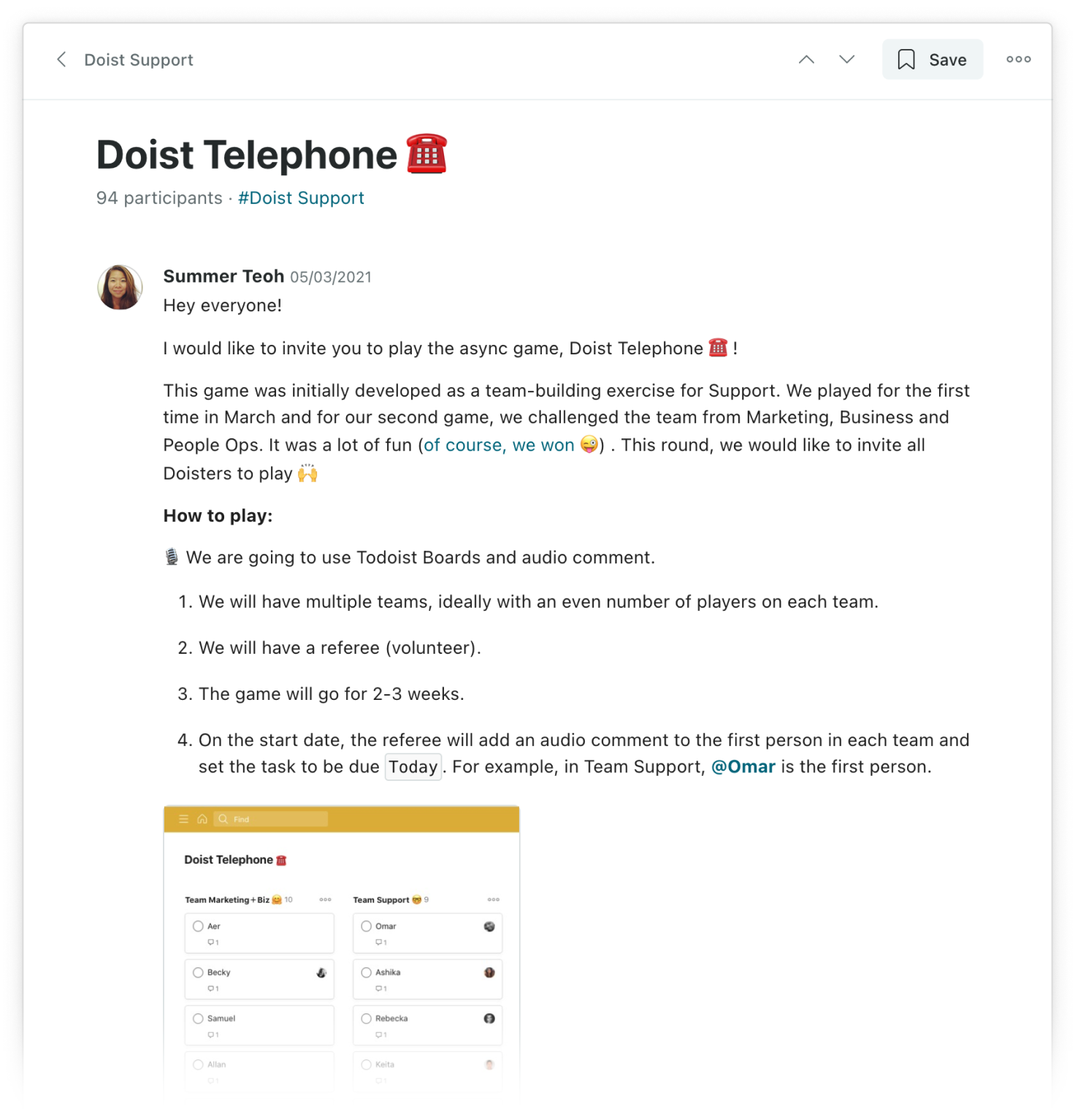
- Space to chit chat separate from work. Twist is a thread-first tool, but every team needs an informal place for chit chat. That’s why we designed the app to separate out threads — for more in-depth work discussions — from messages — more informal back-and-forths. At Doist, we have a company-wide group message where we drop GIFs, share interesting tidbits, and discuss current events. All teammates are added, but anyone can opt out, mute, or disregard entirely at any time. Nothing of work importance is discussed here, so people can choose when they want to hangout at the company “water cooler” and when they want to be more heads down in their work. Many teams within the company have created similar group chats for smaller team chit chat too.
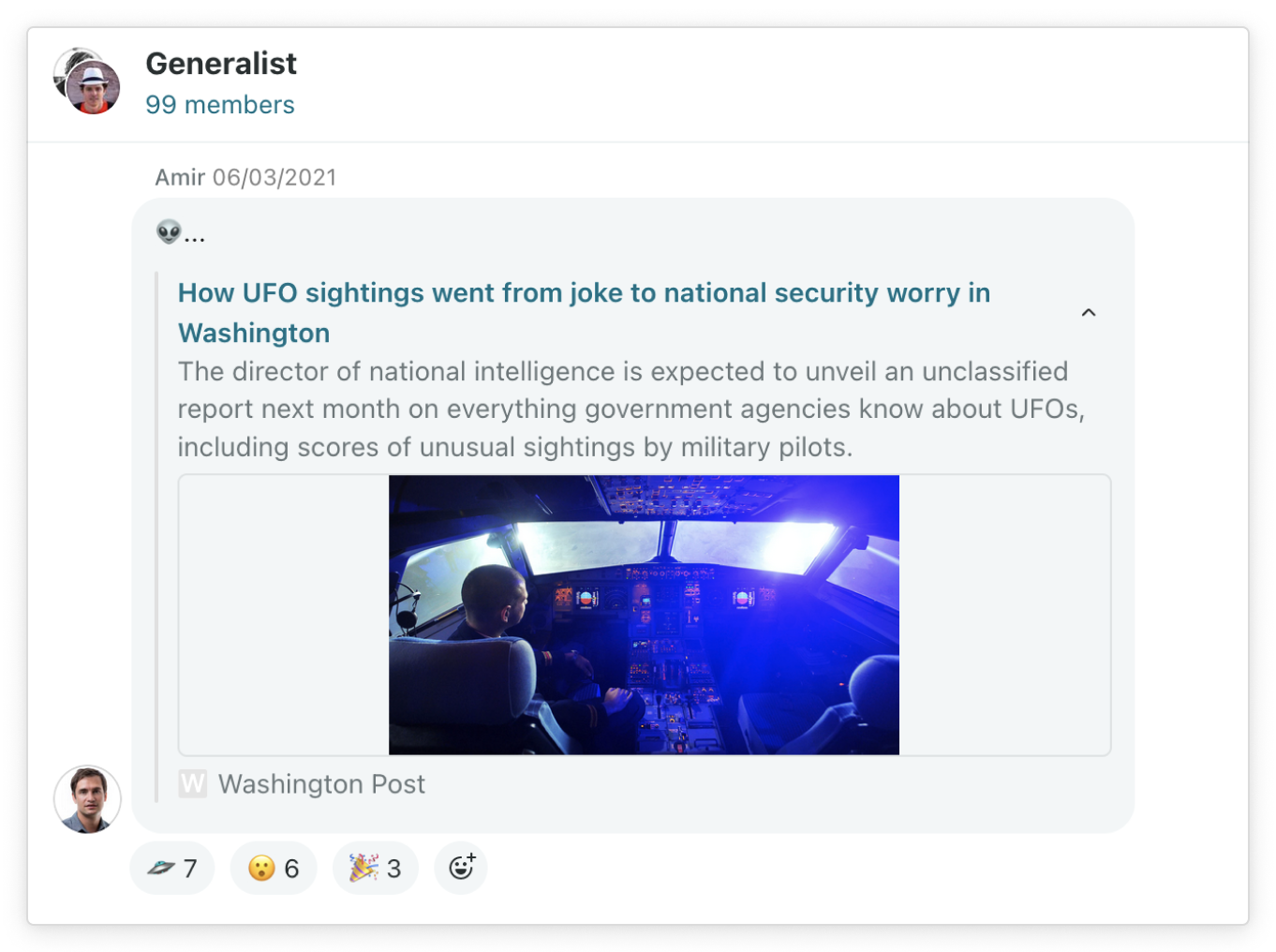
What’s next?
At Doist, we’re constantly experimenting with ways to foster human connection in an async-first workplace. As distributed work becomes more commonplace, new products and services are being built to meet this demand for connectivity. Startups like Kona are helping to automate rituals to build cohesiveness. Atium is tackling the team games sector. So Work is creating customized virtual spaces for coworking and socializing.
But as our ability to literally recreate the office virtually increases, we need to be careful not to revert back to old ways of doing things: rewarding face time and presenteeism over real productivity and favoring those who are able and willing to show up for non-work activities over those who aren’t.
Let’s continue to find new, innovative ways to capture the positive aspects we miss from the office without losing sight of the things that make async work work better for humans in the first place.
3 things worth sharing this week...
Could you imagine?! pic.twitter.com/Q9tLqMkMJl
— Krystal Wu (@HelloKrystalWu) February 7, 2023
- This graphic from WorkshopWednesday.co that illustrates how, contrary to popular belief, async decision-making can allow teams to move faster than waiting for a time when everyone's available for a meeting:
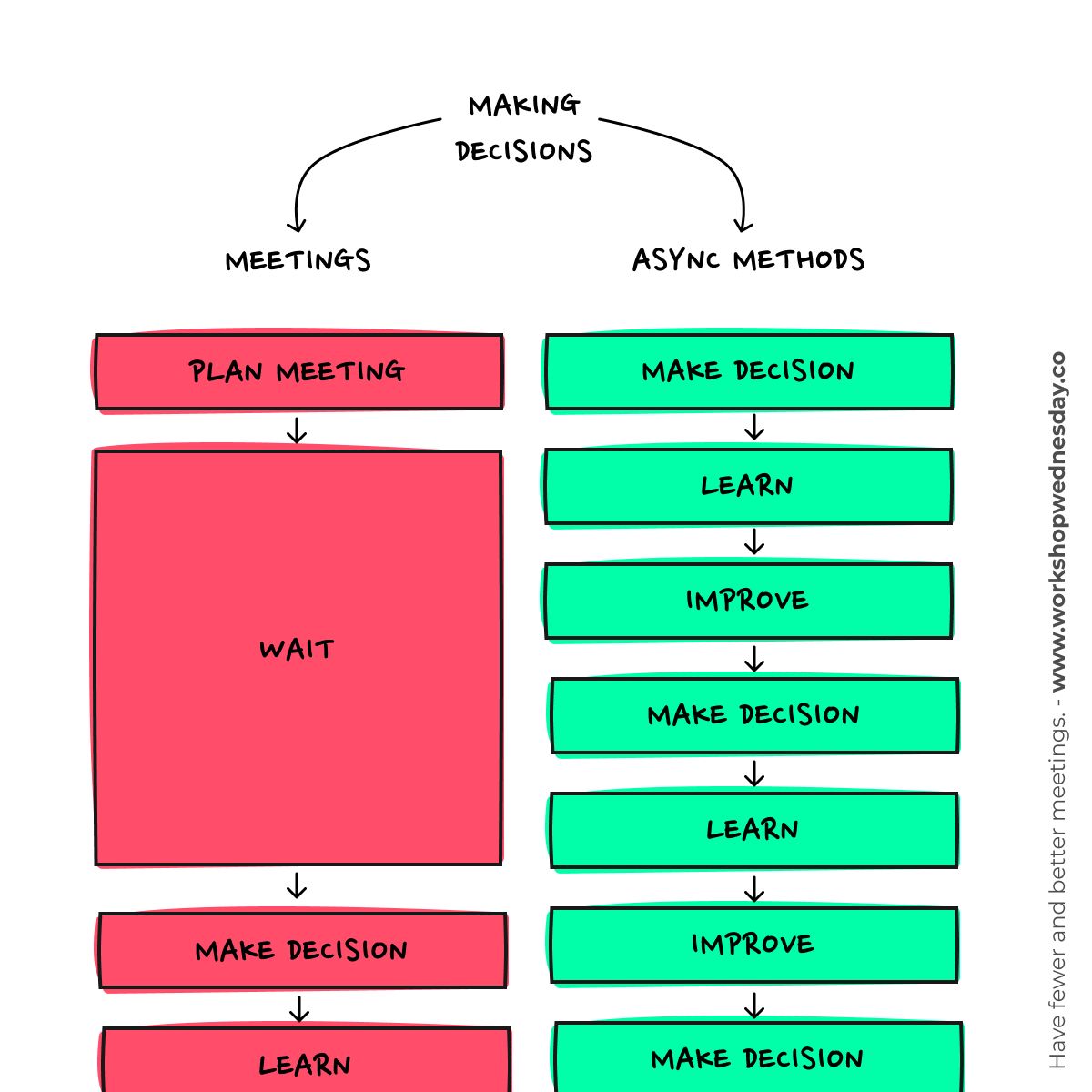
- This LinkedIn post from Oyster CEO Tony Jamous:
It’s official.
When employees don’t have to commute, they work.
A new report by the National Bureau of Economic Research found that, of the average 72 minutes saved by not commuting each day, employees dedicated:
🧑💻 40% to primary and secondary job tasks
🏝 34% to leisure
🤝 11% to caregiving
Couple this with the fact that cutting out a commute makes disruptions like traffic and train delays irrelevant — and that's a massive boost to productivity.
And, more importantly, employees are better rested and more connected with their loved ones.
It’s a win-win-win ❤️
What’s Twist? Twist is an async messaging app for teams burned out by real-time chat, meetings, and email.
You don’t need to use Twist to get a ton of value out of this newsletter and community. But if the topics we talk about resonate with you, there’s a good chance the app will too. See what makes Twist different →
🌎 Built asynchronously by the fully remote team at Doist
